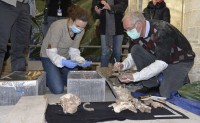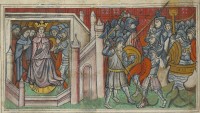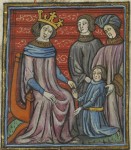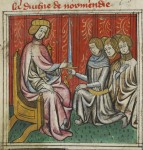 Scandinavian researchers have exhumed the bones of two direct descendants of Rollo, the 10th century Viking founder of the Duchy of Normandy, in an attempt to answer the long-debated question of whether Rollo was Danish or Norwegian.
Scandinavian researchers have exhumed the bones of two direct descendants of Rollo, the 10th century Viking founder of the Duchy of Normandy, in an attempt to answer the long-debated question of whether Rollo was Danish or Norwegian.
Historians have differed on the matter of Rollo’s national origins since at least the 11th century. Norman historian Dudo of Saint-Quentin (ca. 965-1043) said in his Historia Normannorum that Rollo was the son of a “Danish” king who was exiled and made his way to France, but at the time Dudo was in the employ of Richard II of Normandy who was allied to the Danish king Sweyn Forkbeard. He had a dog in the hunt, as it were, and cannot be considered reliable on this question. Goffredo Malaterra, a monk in Sicily writing in the late 11th century, said Rollo hailed from Norway. In the 13th Norwegian-Icelandic sagas Heimskringla and Orkneyinga, Rollo appears as Ganger-Hrólf, the son of Rognvald Eysteinsson, yarl of Møre in western Norway. (Rollo is a Latinization of Hrólf.)
 With these conflicting and vague sources, historians have argued the point for centuries. It matters because of how important Rollo was to European history. His raids along the Seine so bedevilled Charles III, aka Charles the Simple, King of Western Francia, that he finally bought Rollo off with huge tracts of land between the city of Rouen and the mouth of the Seine in exchange for him switching from raider to protector. He appears in only one primary source: a charter from 918 which mentions the lands ceded to Rollo and his “Northmen on the Seine.” It seems Rollo ruled those lands as Count of Rouen until at least 927 after which his son William I Longsword acceded to what would become known during his rule as the Dukedom of Normandy, after the Norsemen who founded it. William Longsword’s son was Richard I of Normandy. Richard I’s son was Richard II. Richard II’s son Robert I was the father of William the Conqueror.
With these conflicting and vague sources, historians have argued the point for centuries. It matters because of how important Rollo was to European history. His raids along the Seine so bedevilled Charles III, aka Charles the Simple, King of Western Francia, that he finally bought Rollo off with huge tracts of land between the city of Rouen and the mouth of the Seine in exchange for him switching from raider to protector. He appears in only one primary source: a charter from 918 which mentions the lands ceded to Rollo and his “Northmen on the Seine.” It seems Rollo ruled those lands as Count of Rouen until at least 927 after which his son William I Longsword acceded to what would become known during his rule as the Dukedom of Normandy, after the Norsemen who founded it. William Longsword’s son was Richard I of Normandy. Richard I’s son was Richard II. Richard II’s son Robert I was the father of William the Conqueror.
 This January, French government and church authorities granted the research team permission to open the tomb of Rollo’s grandson Richard I and great-grandson Richard II. This is only the second time a French king’s tomb has been opened since World War II. On Monday, February 29th, Per Holck, Professor Emeritus at the University of Oslo, and University of Copenhagen geneticist Andaine Seguin Orlando, opened the two small ossuary coffins buried under the floor southern transept of the gothic church of Fécamp Abbey. Inside one of them were the skeletal remains of Richard II, known as Richard the Good, including a lower jaw with eight teeth.
This January, French government and church authorities granted the research team permission to open the tomb of Rollo’s grandson Richard I and great-grandson Richard II. This is only the second time a French king’s tomb has been opened since World War II. On Monday, February 29th, Per Holck, Professor Emeritus at the University of Oslo, and University of Copenhagen geneticist Andaine Seguin Orlando, opened the two small ossuary coffins buried under the floor southern transept of the gothic church of Fécamp Abbey. Inside one of them were the skeletal remains of Richard II, known as Richard the Good, including a lower jaw with eight teeth.
They were hoping to find teeth because extracting ancient DNA is tricky and the genetic material inside teeth is well-protected by the outer layers. Holck and Orlando retrieved five of the teeth. They will be tested at the University of Oslo and the Centre for GeoGenetics at the University of Copenhagen. If all goes well, the research team and French authorities will announce the results in the autumn.
 The remains of the Richards have been moved before. Richard I, who rebuilt the church after it was destroyed in Viking raids, and Richard II, who made it a Benedictine monastery, were initially buried outside the church. Richard II’s great-great-great-grandson Henry II of England had his ancestors’ bones reburied inside the church. Remains that are not in their original location can be problematic to authenticate. I don’t know if this study plans to do anything specific to confirm first and foremost that they really are the bones of Richard II. Also, if the bones were treated at any point — boiled to remove the flesh and make them a clean fit for a small coffin — DNA extraction will be even more challenging, albeit not impossible. Teeth are the Fort Knox of the body.
The remains of the Richards have been moved before. Richard I, who rebuilt the church after it was destroyed in Viking raids, and Richard II, who made it a Benedictine monastery, were initially buried outside the church. Richard II’s great-great-great-grandson Henry II of England had his ancestors’ bones reburied inside the church. Remains that are not in their original location can be problematic to authenticate. I don’t know if this study plans to do anything specific to confirm first and foremost that they really are the bones of Richard II. Also, if the bones were treated at any point — boiled to remove the flesh and make them a clean fit for a small coffin — DNA extraction will be even more challenging, albeit not impossible. Teeth are the Fort Knox of the body.
Spoiler Alert!
If you’ve been watching Vikings on the basic cable station formerly known as the History Channel, Ragnar’s brother Rollo is very loosely based on the historical Count of Rouen. They had to conflate sagas and mess with the timeline to make them brothers, so who knows if he’ll wind up in Normandy on the series, but he’s in France and married to Charles the Simple’s daughter, who may or may not have existed and if she existed, may or may not have survived to adulthood, but is mentioned as Rollo’s wife in William of Jumièges 11th century chronicle Gesta Normannorum Ducum and in Dudo’s history which relied heavily on Jumièges’.